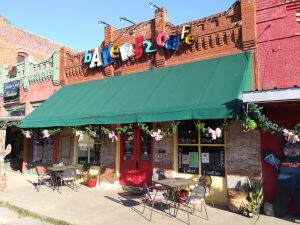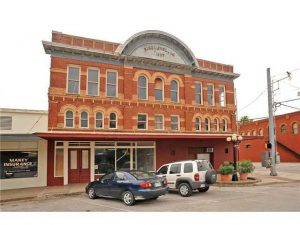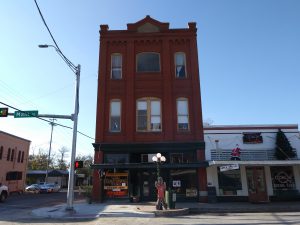Smithville Historical Downtown Walking Tour

Welcome to the City of Smithville, Texas!
The village of “Old Smithville” was laid out on 640 acres of land granted to Thomas J. Gazley and Lewis Lomas. The town was located along the Colorado River in the northeast section of present Smithville. There were mercantile stores, dry good shops, and a Masonic lodge. In 1876, the first post office was established with John Pride Jones as postmaster. The Taylor, Bastrop & Houston Railroad, later a part of the Missouri, Kansas & Texas system, arrived in 1887, and the town relocated along the tracks. The legend is that a coin was tossed to decide if the name would be changed to Burlesonville for Murray Burleson, who gave land for the railroad depot. The coin toss resulted in “Smithville” being retained as the name, apparently in honor of pioneer settler William Smith. The town was incorporated in 1895 and T. C. Collins served as the first mayor.
History is an elevated art form in Smithville. Public art around town also puts history into context. The swallowtail sculpture at the Gazebo Park is a memorial of a tragic train explosion in 1908. A bust of one of the town’s founders, Dr. Thomas J. Gazley, is on display at Independence Park. Gazley helped to write the Texas Declaration of Independence and the Texas Constitution. During the Texas War for Independence, he fought as a citizen soldier-surgeon in the battles of Gonzales, Concepcion Mission, and San Jacinto. William Smith’s family arrived several years after Dr. Gazley. They owned a store and were early influences on the area.
Local businessman Murray Burleson learned of the approach of the Taylor, Bastrop, and Houston railroad, and worked with several partners to purchase land tracts in the Gazley and Loomis Surveys. A new town located adjacent to the railroad tracks was thereby platted and those seventeen families moved their homesteads from the Colorado River site to the railroad location about two miles west. By negotiation and a gift of land, Burleson persuaded the railroad to erect a Terminus (a depot facility) at the new town site, and the TB&H steamed through in 1887. Almost overnight, the town flourished with new railroad workers, followed by commerce and the service industries needed to support the growing population. Smithville becoming the largest city in Bastrop County for nearly 50 years.
Map Legend
- Railroad Museum & Park, 1st Street & Main Street – Built 1887
- Bell's Barber Shop, 106-108 Main Street – Circa 1900
- Polansky Bros. Meat Market, 110 Main Street – Built 1895
- Hansen's Bakery, 112 Main Street – Built 1895
- Smithville Cigar Store, 114 Main Street – Circa 1895
- McCaskill Building, 116 Main Street – Built 1897
- McCaskill Building, 104-106 E. 2nd Street – Built 1895
- Janek Motor Co., 108-110 E. 2nd Street – Built 1903
- Pines Hotel & Cafe, 113-117 E. 2nd Street – Built 1910
- Yerger Hill & Son, 200-202 Main Street – Built 1898
- Dr. Hoch's Clinic, 204-206 Main Street – Circa 1900
- Chancellor's Dry Goods, 216 Main Street – Built 1963
- Hill Building, 218 Main Street – Circa 1895
- Texas Theater, 300 Main Street – Built 1904
- Masonic Temple – Built 1903
- Dickson building, 219 Main Street – Built 1896
- Gindler's Department Store, 213-215 Main Street – Built 1895
- Powell Buildings, 207-209 Main Street – Circa 1895
- Ragsdale's, 205 Main Street – Built 1895
- First State Bank, 201 Main Street – Built 1902
- Marhill's, 111-117 West 2nd Street – Built after 1900
- Eagleston's Saloon, 119 Main Street – Built 1888
- City Drug Store, 117 Main Street – Built 1889
- Bollier's, 115 Main Street – Built before 1891
- City Grocery, 113 Main Street – Circa 1905
- Bock's Grocery, 111 Main Street - Built 1909

1. Railroad Museum & Park
Built 1887
Begin your tour at the Railroad Museum & Park, which currently serves as the Smithville Chamber of Commerce.
1. The first railroad depot was built in Smithville in 1887, burning a few years later. In 1893, the MKT completed its tracks linking Houston with smithville. The second depot was built in 1895 at the Y in the tracks further west. The large railroad YMCA building was from 1899 to 1926. The smithville Railroad Park is on land donted by the railroad and contains the Chamber of Commerce building and Railroad Museum. A small depot moved to the park from nearby West Point. The cupola on the gazebo, which is on the site of 1909 depot, came from Smithville’s 1916 City Hall.

2. Bell’s Barber Shop
Circa 1900
In 1905, Bell’s Barber Shop was known for its opulence. The other half of the building was a restaurant and later the Cue Club beer parlor.

3. Polansky Bros. Meat Market
Built 1895
This building was constructed in 1895. By 1909, Edward and Marie Polansky had a bakery here, and their sons operated Polansky Bros. Meat Market & BBQ. By 1929 “Grocery” had been added to the name. After 1946, the building housed either a grocery and/or BBQ establishment owned by Mikesa or Charlie Ebner’s family until it closed in 2003. It is currently a local community theater, Playhouse Smithville.

4. Hansen’s Bakery
Built 1895
Buildings 112 and 114 are identical with lapped brick facades. Built in 1895 as a grocery store, by 1909 this was a restaurant. The post office was here in 1911, going through four postmasters until 1920, and once having been robbed. Other businesses in the divided building have included a bakery, barber shop, watch repair, septic service, needle craft shop, religious bookstore, and two antique shops. It is once again a bakery.

5. Smithville Cigar Store
Circa 1895
The second of two identical buildings was the Smithville Cigar Store in 1895. From 1910 to 1925, the building housed a saloon, a shoe shop, a dry goods store and the shop of Jeweler A.C. Wrede and offical railroad watch inspector. In 1925, the building was divided for a barber shop, a cleaning and pressing establishment, a veterinary clinic, a beer joint, and then became the Liberty Cafe.

6. McCaskill Building
Built 1897
Built in 1897 by K.H. McCaskill, a local blacksmith, several grocery and general stores have occupied the first floor with its unusual recessed entry. The second floor was used by the Smithville times (1897-1905) and as lodge rooms for the Masons and the Oddfellows & Rebekash (1897-1985).

7. McCaskill Building
Built 1895
K.H. McCaskill also built this small building in 1895 with used brick from an earlier building in town. Thus, the materials in this building are thought to be the oldest in the commercial historic district. It housed borders until 1905 when Marie Polansky opened a small bakery and grocery store downstairs. The first floor was divided in 1934 for small businesses such as the City Shoe Shop, located here until 1970.

8. Janek Motor Co.
Built 1903
This large, triple-bay building with a checkered brick facade was built in 1903. large businesses which operated here include a harness shop, the farm implement shop of Smithville Furniture Co., the Janek Motor Co., Smithville Cleaners and Laundry, the Smithville Produce Co., a 7-Up distributorship, and a bakery which was closed for a week during World War II due to a sugar shortage. This was the “Temptation Nation Employment Agency” in the 1997 movie, Hope Floats.

9. Pines Hotel & Cafe
Built 1910
This large 1910 hotel building was built by the Hill family to accommodate railroad workers and traveling salesmen. It included a 16-car garage on the first floor. On the west side of the building, in the single-story cafe, Dan Rather spoke to the Lions Club in 1967, before the hotel closed in 1968. The cafe became “Honey’s Diner” in the movie, Hope Floats.


10. Yerger Hill & Son
Built 1898
This 1898 building, with two storefronts, was the home of the Hill family’s large hardware and eventually dry goods business that started at Alum Creek in 1875 under the name of Yerger, Hill & Son. The Bank of Smithville started here in 1895 before becoming First State Bank. The bank was moved across the street when the Hills opened their dry goods store in the space. In 1913 Yerger Hill had his exterior storefronts remodeled with black “mirror” tiles, plate glass windows and tiled entries showing the name of the business. The interiors still have their pressed metal ceiling and skylights. In 1997, the corner building was the photo shop in Hope Floats.


11. Dr. Hoch’s Clinic
Circa 1900
This building was also built by the Hill family about 1900. A grocery store and restaurant occupied the two storefronts until 1944 when Dr. Hoch opened a clinic at 204 main. Dr. Thomas took over the clinic in 1952 and called it the Smithville Hospital. Law offices of Robert Perman and Yerger Hill were later housed at 204 Main, and several pharmacies were at 206 Main from 1934 to 1991.


12. Chancellor’s Dry Goods
Built 1963
Built in 1963 by J.H. Chancellor, the building housed his dry goods business until 1957. Buster Brown, promoting the children’s shoes of a St. Louis company, visited the shoe department in 1915. The store features an elegant staircase leading to the mezzanine. The store original boasted detailed brick and iron work.

13. Hill Building
Circa 1895
This building was constructed about 1895 by prolific local builders, Turner & Son. It housed the Rabb & McCollum furniture store and undertaking parlor until 1907, followed by the J.M. Moffitt’s variety store. Beginning in 1930, a series of drug stores, City drug Co., Mize Drug Store, and Crow Pharmacy were here. The upper floor provided office space for attorneys, dentists and physicians who dropped prescriptions down to the druggist through a hole in the floor.

14. Texas Theater
Built 1904
One of the two three-story brick buildings, this one was constructed in 1907 for the furniture store of Rabb & McCollum, on the first floor, and their undertaking business on the second floor. For years, an unclaimed embalmed body was kept in a coffin on display in the upstairs funeral parlor. Local boys would use “the mummy” to scare newcomers. A hardware store and meat market have also been located on the lower floor. In 1930, the Texas Theater opened, and a movie house survived here until 1970. the rear of the building facing Third Street (now Loop 230) was office space from 1910 until 1962.

15. Masonic Temple
Built 1903
Houston architect George E. Dickey designed this three-story all-brick building for the J. Nixon Masonic Lodge. Completed in 1903, the structure was once the tallest building in Bastrop County. The second floor rooms were offices, and the first floor was occupied by John Haynie’s grocery store (1905-1930), a furniture store, an auto supply, and fashion clothing designer Patricia Wolf. The second and third floors are now used as loft apartments, a popular new trend on Smithville’s Main Street.

16. Dickson Building
Built 1896
This building was designed by George P. Cook and built by J.B. Garrett in 1896 for H.J. Dickson. A local radio station transmitted from the second floor in the 1930s, and a number of drug stores have been here, including Trousdale’s and Smith’s. The north side of the building has a mural of a locomotive, one of several fine murals in the Smithville downtown area. Lyndon Johnson was once visiting Smithville when he complained of stomach pains. The soda jerk at Trousdale’s Drug Store gave him a bottle of “Pluto” water, an antacid; however, Mr. Johnson was later taken to Austin for an appendectomy.

17. Gindler’s Department Store
Built 1875
Three small buildings make up what appear to be one large building. Buildings 213 and 215 Main are two-story buildings constructed in 1895. A dry goods store, a furniture company and the Green Lantern Dance Hall were here prior to 1932 when the United Gas Company took over the buildings and the single-story building at 215 Main. Gindler’s Department Store was located at this address for 25 years.



18. Powell Buildings
Circa 1895
These two buildings were constructed about 1895 and were often used for one business. The Falkenberg Drug Store was located here from 1918 until the 1950s. C&C Electric and the Sears Catalog store occupied the building until 1980, when Western Auto moved here. The upper stories still have the original brick detail.

19. Ragsdale’s
Built 1895
Built in 1895, this building housed the tailor shop and clothing store of J.B. Johnson from 1898 to 1919. the building was then purchased by Charles Ragsdale for his jewelry business, which was started in the Powell Building in 1913. He was the offical watch inspector for the MKT Railroad. The second floor was used by the Independent Order of Odd Fellows (IOOF) in 1895. Ragsdale’s daughter operated the business until it closed in 1996, and, until then, Ragsdale’s was Smithville’s oldest retail business.

20. First State Bank
Built 1902
The original red brick building was built in 1902 for First State Bank which had been organized across the street in 1895. Doctor’s offices were located on the second floor, along with an operating room. In 1950 the bank took over a single story building at 203 Main, which had housed the Trousdale & Son Drug Store.

21. Marhill’s
Built after 1900
Five one-story brick buildings, typical of business blocks in Smithville, were built after 1900 just off Main Street. Various businesses have been here including a bank, grocery stores, dry good stores, a bakery, an undertaking parlor and one of the early post offices.

22. Eagleston’s Saloon
Built 1888
This building was constructed in 1888 for Sass Grocery. By 1890, it was Edward H. Eagleston, who hd widespread land and business interests. With the advent of prohibition, the building again became a grocery, and eventually Shirocky’s Grocery in 1934.

23. City Drug Store
Built 1889
Constructed in 1889 as a meat market, by 1909 a grocery had been added to this building. After 1915, the Falkenburg Drug Store moved here, followed by the City Drug Store until 1932. Various businesses filled the space until 1995 when the building became a restaurant.

24. Bollier’s Dry Goods
Built before 1891
Built prior to 1891, this 1-1/2 story brick building with a mezzanine was constructed as the Lone Star Saloon. The medallion is a representation of the offical portrait of thomas Jefferson Gazley, the first known settler in the community. Several businesses, including the Bank of Smithville and a drug store were here before Dessie Bollier had her dry goods and clothing store at this location for 30 years.

25. City Grocery
Circa 1905
The grocery store buildings at 113 and 111 main Street are nearly identical, and probably built by the same contractor. Built about 1905, City Grocery was located here until the 1970s.

27. Bock’s Grocery
Built 1909
Built in 1909 for a meat market, L.C. Bock bought the market in the 1930s to open a Red & White store, which closed in 1964.
Learn more about Smithville’s history at the Smithville Chamber of Commerce, located at the Railroad Museum and Park, 1st Street and Main, or call the Chamber at 512-237-2313.

